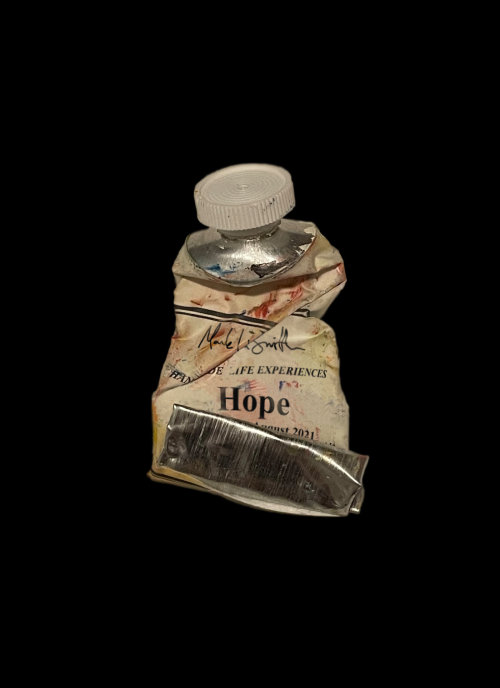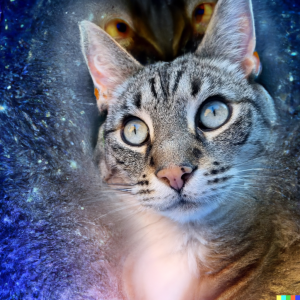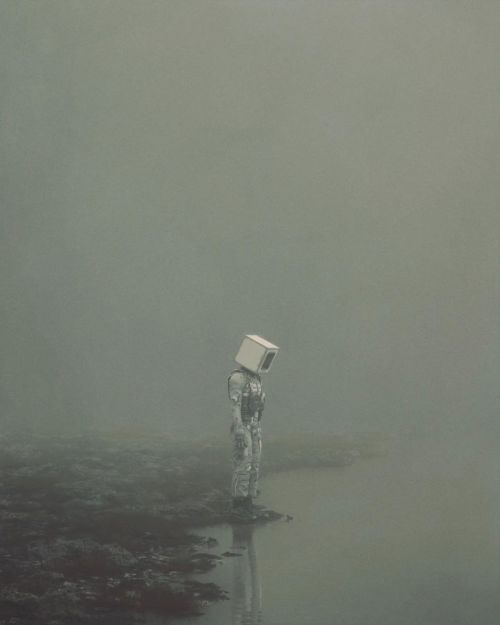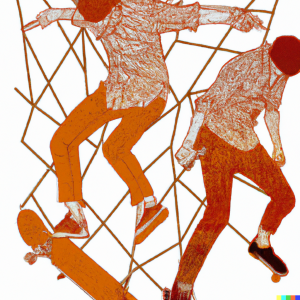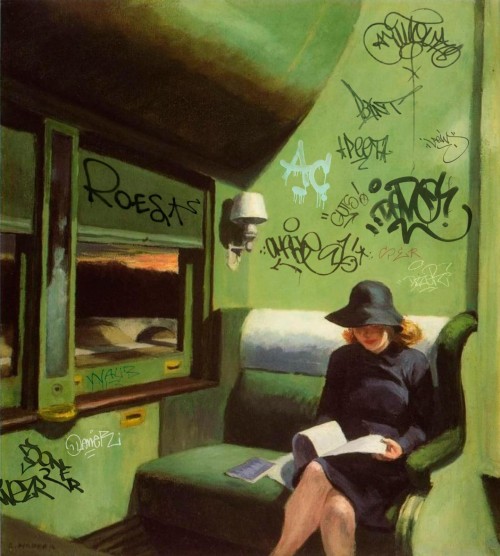I went to Soho House this week (a friend of mine with a Proper Job was paying), and met two of the worst people I have ever encountered – one man who proudly told me all about the Porsche he’d bought with his Covid loan (a loan he never intends to pay back, obvs), for which he bought himself a personalised number plate reading ‘CBILS’ (no, really), and his mate who told me with an entirely straight face that he believed LBC’s James O’Brien was a ‘terrorist’ and ‘extremist’ who should be banned from the airways for his promotion of ‘violent left-wing ideologies’. Both of these choice specimens chose to inform me that, despite having hitherto been staunch Tory voters (imagine my surprise!) that they would be voting Labour in the next election because ‘I mean, it’s just a fcuking joke, isn’t it?’.
So cling to that small grain of hope, that gramme of comfort, the knowledge that, whilst we may be in for some Tough Times Ahead, our new Prime Minister has so fcuked her first few weeks in the job that even her party’s core constituency of voters – cf the very worst cnuts this benighted country can spawn – are thinking it’s all a bit much. Who knows, with a bit of luck this will tank the fcukers forever and it will be a Labour government overseeing the glorious irradiated future under the terrifying horrorsun!
Oh.
Anyway, the words and the links. Trust in the words and the links.
I am still Matt, this is still Web Curios, and in the unlikely event that the two people described in the first paragraph ever find this: you are DREADFUL and I despise you.

By Sage Barnes
LET’S START WITH A TRIP BACK TO THE 80s COURTESY OF TOM SPOONER AND HIS RECORD COLLECTION!
THE SECTION WHICH REALLY HOPES THE CHESS BUM THING IS TRUE TBH, PT.1:
- Meta Make-A-Video: It’s getting quite hard to keep up with the giddy pace of innovation in the AI space, with a new exciting/terrifying (delete per which end of the owner/worker spectrum you feel closest to) development seemingly lurching portentously over the horizon every six hours or so – it can only be a matter of weeks before some ill-advised coding collective release a ‘turn your dreams into NFTs’ codebase on Github or something. This week’s ‘it’s ostensibly a fun and exciting new frontier in terms of human / machine collaboration!’, which will inevitably turn into ‘hm, we didn’t think through the implications of this as thoroughly as, on reflection, we may have wanted to!’ in a few years’ time is ‘turn text into machine-generated video’, which, based on the limited, curated examples currently on display, is potentially-seismic for the visual and creative industries. You don’t need me to try and explain the tech – which is good, because, honestly, I know my limits – just know that Meta is confident enough in the tech to publish a bunch of examples of how good its machines have become at imagining things like ‘a schnauzer flying a biplane’ as CG videos. You can’t, to be clear, play with any of this yet – this is just a teaser blogpost with some examples for you to gawp at – but it was interesting that yesterday also saw the announcement of a separate model called Phenaki doing exactly the same thing, suggesting that we’re probably only about three weeks from Stable Diffusion announcing an Open Source version of this and chucking a stripped down model online with a web interface so that all the world’s angriest men can w4nk themselves stupid imagining an Aryan mermaid film. I have little to say about what this stuff looks like – it’s magic, who am I to criticise the resolution? – but it’s worth taking a moment to reflect on what it’s going to do to everything when we can command machines to imagine us 90s of video on demand (spoilers: I am not optimistic). Oh, and while we’re here doing ‘stuff that is on the cusp of being real’, here’s another in-development machine which is designed to generate 3d models of anything you can think of, which on the one hand is an incredible boon for anyone making anything in digital but which on the other is very much the first bell tolling for all of you who got really into Blender in lockdown.
- StockAI: There’s something rather exciting and frothy about the early days of a new technology entering a marketplace, particularly in terms of watching all the ways in which enterprising grifters seek to monetise it to the stupid and gullible. So it is with StockAI, which has sprung up out of nowhere to offer a service literally noone asked for and which in no way needs to exist – a website to browse, create and buy AI-generated stock images. Now, given that everyone was given access to Dall-E this week and therefore can access exactly the sort of tech this is built on, one might wonder what additional benefit there is to paying StockAI $34 a month for the privilege of using their Stable Diffusion instance; as far as I can tell, there really isn’t one (beyond the ability to search an extant database of not-very-good AI generated imagery with some pretty generic category tags), but I am grudgingly-impressed by the grift on display here. More practically this is also proof positive, contrary to what you might have feared, that stock photography still has a few months left before its rendered totally obsolete – the few of you who read this who work at Getty can probably stop searching for new jobs, at least for a few weeks.
- The Feral Atlas: It’s quite hard to describe this, so apologies in advance for the barely-explicatory language soup that follows (look, it’s early and I was out last night at a gig and didn’t get to sleep til nearly 2, and frankly four hours sleep isn’t enough to do a Curios on and whilst I know you’re not here to listen to me whinging about being tired I just want you to have a vague explanation as to why things are a bit…slow round here this morning) – The Feral Atlas is…oh, God, see? Let’s try again. The Feral Atlas is one of those glorious sites which effectively acts as a brilliant, idiosyncratic series of walks or journeys or talks, guided by clicks and curiosity, about The World And How We Relate to it. Click around and be taken on a proper journey of intellectual discovery about the world we live in and our relationship to / impact on it – I know it’s a bit lazy to just dump from the ‘About’ page, but I think this is a nice overview: “Feral Atlas invites you to navigate the land-, sea-, and airscapes of the Anthropocene. We trust that as you move through the site—pausing to look, read, watch, reflect, and perhaps occasionally scratch your head—you will slowly find your bearings, both in relation to the site’s structure and the foundational concerns and concepts to which it gives form. Feral Atlas has been designed to reward exploration. Following seemingly unlikely connections and thinking with a variety of media forms can help you to grasp key underlying ideas, ideas that are specifically elaborated in the written texts to be found in the “drawers” located at the bottom of every page.” Honestly, this is WONDERFUL, not least because (if you’re me, at least) you’re always half-a-beat behind whoever curated/arranged this, and as such the associations and themes are always interestingly off-kilter.
- NightDrive: On the one hand, this is ‘just’ an in-browser coding demo of driving along a winding road by night, visualised in a vaguely-80s, synthwave-y style; on the other, it is honestly one of the most beautiful and hypnotic things I have seen in years and with the right soundtrack I could literally sit and stare at this for hours. Honestly, throw this onto a big telly and put some Kavinsky on and enter the meditative, zenlike state of a teenager on quaaludes in the arcade in the late-80s. This would be ACE in a gallery setting imho.
- AAWUM: As the war in Ukraine continues to rumble grimly onwards, and as Cuddly Vlad’s rhetoric becomes hotter, and as combatants prepare for what will doubtless be a spectacularly-miserable winter of fighting and freezing and dying (I don’t know about you, but I’m finding ‘yes, but at least we’re not in Ukraine’ a reasonably-effective mantra when things start looking a bit on the grim side here), take a moment to browse this curated collection of art and images created in response to the conflict by people around the world. This isn’t selling anything – it’s just a selection of images pulled from around the world and the web, documenting artistic responses to the past 8 months of fighting, curated by Ukrainian creative agency Obys.
- Walky Space: OH GOD I LOVE THIS. Walky Space is a webtool/webtoy which lets anyone make their own…what would you call the outputs? Navigable digital collages? Basically you can create an infinite digital canvas onto which you can drop words, images, etc, wherever you like, and which then becomes a permanent, hosted page which can be ‘walked’ around by any visitors to the site. It’s all 2d, and it’s all very lo-fi, and there’s something so so so beautiful about the feel of the experiences here – there are a few that they point you towards on the homepage, but I would encourage you to play around and make your own. If nothing else – and apologies for the tooth-grindingly twee nature of the following observation – this would be THE cutest digital means of delivering a proposal or a love letter, and for the right sort of person (probably someone who doesn’t automatically recoil at the sound of a ukelele, or the thought of crocheting a doily) this will be the most charming thing in the world.
- Key4All: I haven’t featured anything by MSCHF in here for a while – perhaps because the schtick doesn’t feel either new or hugely in keeping with The Times We Are Sadly Being Forced To Live Through (or because I started getting the vague vibe that they are basically MrBeast for people who work in marketing), but this new ‘drop’ (SORRY) caught my interest, not least because it is basically the ur-distillation of ‘every videogames PR brainstorm I ever sat in in the 00s’. The gimmick this time is that MSCHF have an ACTUAL CAR available to anyone lucky enough to buy the key – and the key is for sale on their website for just a few bucks! Except there are HUNDREDS of keys, all identical, and only one car, which is hidden in a secret location – the game then becomes to see which of the people who shelled out for a key will become the first to find the car and drive it off. There are a few additional mechanics – the keys and the car are fitted with sensors offering a loose, colour-based proximity sensor; there is a hotline offering cryptic clues as to the vehicle’s whereabouts – but that’s basically it, which is admirably simple and stripped back, and, honestly, sounds like a lot of fun. As ever with MSCHF’s stuff you can probably rip this off with reasonable impunity, but please remember to credit Curios in your award acceptance blogpost.
- The Pleasure Pursuit: Not in fact anywhere near as filthy as its title makes it sound, The Pleasure Pursuit is instead a website promoting the new collaboration between fashion brand Coach and the pop artist Tom Wesselmann, and it’s SUCH a pleasant change from the recent spate of 3d-navigable metaverse abortions. There’s a real sense of interest in the artist’s style and ethos, and the way the website is structured – lots of very nice scrolling work and LAYERS and a really nice sense of motion and depth which you don’t always get with this stuff – actually makes sense, and overall it’s an unusually-educative example of how to present a new product line. I have literally no fcuking idea what the whole ‘collect the oranges’ thing is about, though.
- Welcome To My Garden: This does rather feel like a relic from an earlier, more trusting time, when the web was simply an infinite space full of all the friends we hadn’t met yet rather than, as it has become, the stickiest prison we ever invented for ourselves, but I approve wholeheartedly of its Pollyannish vibes. Welcome To My Garden is basically Airbnb but for, er, other people’s gardens – specifically, gardens where their owners are totally ok with you pitching up and putting a tent in them. This is an initiative which apparently started out in Belgium in lockdown and which is slowly growing outside those national borders to encompass sites across Europe – which, obviously, is a LOVELY and cute idea, and a heartwarming one, but equally one which raises so many questions about how the logistics work. Do you give the strangers kitchen access? Do you run a ‘bring your own compostable toilet’ policy? Do you turn a blind eye if your garden guests decide to, I don’t know, barbecue a pigeon for dinner? Christ, how miserably English of me – presented with a wonderful example of the web’s potential as a network for sharing, I instead start obsessing over minor questions of form and etiquette. This is why we don’t deserve nice things. Anyway, I have just seen that there’s someone called Mike who’s offering a space in his garden about 15m from my girlfriend’s house, so WOW is she going to be in for a happy surprise when she finds out where we’re going for our Autumn break this year.
- Big Code: I was talking to my friend Scott the other week about when he thought that the whole ‘AI can now do this thing in seconds which once took you humans hours – sorry for your sudden obsolescence’ thing would come for coding, and he not-unreasonably pointed out that it might take some time given that the people responsible for coding the AIs themselves may be disinclined to hasten their own demise. Except it turns out not all of them have this sort of self-preservatory instinct – Big Code is a new collaborative project looking to develop large language models (LLMs) to write code from text prompts (muchlike GPT-3 can sort-of almost already do, but specifically for devs): “BigCode is focused on developing state-of-the-art LLMs for code. Code LLMs enable the completion and synthesis of code, both from other code snippets and natural language descriptions, and work across a wide range of domains, tasks, and programming languages. These models can, for example, assist professional and citizen developers with coding new applications.” The ability for anyone to spin up a quick, basic bit of plug-and-play code based on their own vague descriptions is objectively amazing and transformative – this is worth keeping an eye on.
- The Decruiter: Based on the past week’s news in the UK, you may not be feeling like you can afford to stop working anytime soon – although it’s actually entirely possible that even having a job won’t make a meaningful difference in your ability to house yourself when your shouldering a grand a month on the mortgage, so, frankly, fcuk it! Do it! Take the plunge! What’s the worst that can happen? If you are considering the long-dreamed-of BREAK FOR FREEDOM, you may be interested in The Decruiter, a service which offers non-judgemental advice and guidance to anyone who’s considering leaving employment. “Quitting something is hard. You might not have anyone to talk to about it. You might feel the need to quit, but you’re on the fence about it. Maybe it doesn’t make financial sense. Maybe you’re not sure what you’ll do next. Maybe you have a ton of questions about unemployment, self-employment, or beginning the job search all over again…We’re not trying to persuade you to suddenly quit your job — rather, we’re here to talk to you and make sure you are truly ready to leave with a series of questions.” Now, I love quitting – it’s a real skill of mine – so given that this service is currently sadly only available in the US, I am willing to extend the same offer to any Web Curios readers anywhere in the world – if you want to quit something, and would like to talk to a stranger who will assess your decision and then reassure you that it is PERFECTLY FINE and DEFINITELY ALL GOING TO BE OK, then just get in touch! This is also, by the way, a solid-gold PR stunt for the right brand.
- The Smurf Research Centre: I spent more time thinking about Smurfs in the past year than I had done in the preceding 41 – this was in no small part due to the fact that lots of ice cream parlours in Rome sell an inexplicable ‘blue’ flavour of icecream (it tastes vaguely like bubblegum, but, honestly, when asked to describe what it tastes like, ‘blue’ really is the most accurate description I can come up with) which is called, in a way in which now horrifies me far more than it did as a kid, ‘Smurf’ flavour (‘puffo’ in Italian), which implies the very real and horrifying possibility that the product is made from the actual mulched bodies of tiny blue creatures. Anyway, this is by way of digressive intro to The Smurf Research Centre, a selection of longform writings on Smurfs and the Smurf universe. You want a breakdown of every single episode ofthe Smurfs? GREAT! You want some deep analysis of Gargamel’s motivations? OF COURSE YOU DO! This is the work of one Stephen Lindholm, who, let’s be honest, we all knew was a man before I even named him.
- Quazel: Ooh, this is interesting – Quazel is a new language learning and exercise tool using AI voice recognition, text-to-speech and (I presume) some sort of GPT-esque backend for the conversation stuff, to afford users the ability to chat with a machine in a variety of languages. I tried this with Italian and was honestly super-impressed, both with the quality of the recognition and transcription, and with the way it which it did a reasonable job of mimicking an actual (if cripplingly dull and stilted) conversation (although on reflection that might just be me). If you’re sick to death of that horny fcuking owl taunting you from within the Duolingo app then this might be a useful alternative.
- Pigeonpedia: ALL YOUR PIGEON INFORMATION NEEDS! “Pigeonpedia aims to answer all the questions that anyone has about pigeons, we want to become the go-to Wiki of Pigeon knowledge. Pigeonpedia was started in January 2020 by Dan, a pigeon aficionado who realized that there were very few dedicated pigeon sites on the internet. Our content is written by Dan, Denise and Cristina, three people who are passionate about pigeons.” This doesn’t in any way appear to be ironic – I think Dan, Denise and Cristina really do like pigeons a lot, and more power to them frankly. If you’ve ever wanted to know the answer to ‘should I feed milk to the pigeons nesting in my window box?’, then now you have a place to go to find the answer (the answer is NO YOU MADMAN WHAT ARE YOU THINKING?).

NEXT UP, A VERY HARD AND VERY FAST TECH-TRANCE SELECTION MIXED BY YASMIN GARDEZI!
THE SECTION WHICH REALLY HOPES THE CHESS BUM THING IS TRUE TBH, PT.2:
- Rescue Matches: This is a classic example of an idea that seemed cute on first inspection but then makes less and less sense the more you think about it – a CLASSIC bit of PR work! Rescue Matches is a US initiative in conjunction with Tinder, designed to riase the profile of rescue dog centres which offer canine pals for adoption. The STAGGERING INSIGHT here is that people who use profile pics featuring dogs on the apps tend to do better than people who don’t (is that…is that true? Is ‘man with dog looking outdoorsy’ not exactly as much of a tedious cliche as ‘bloke looking inexplicably proud with massive bass’ or ‘seemingly-entirely-self-unaware white saviour charity work shot’?), and so this service offers even the dogless the chance to have a pup in their profile thanks to the MAGIC OF TECH. Pick a region of the US, pick from the available dogs, upload a photo, get the dog magically ‘shopped into said photo which you can then download and use on the apps (Tinder for preference, given the partnership). Which, look, is fine up to a point, but…well, at the end of the day all you get is a crap bit of photoshop with a border around it advertising the fact that you can adopt dogs, but there’s no shorturl to take you to the adoption page, no personalisation beyond the image, the images you end up with are shonky at best…it just feels like a missed opportunity tbh. Also – and maybe I am just too cynical for this sort of thing – I think were I to be browsing a dating app to be confronted with the image of someone who’s nakedly using an image of a rescue dog to try and get laid rather than, I don’t know, adopting the dog, or volunteering, or donating, I might…think less of them. Animals – existing to help the emotionally-manipulative get laid since time immemorial!
- Buddio: This is an odd little idea. Buddio is a service which exists to find you people to walk with – not in the real, practical, “here are you and I, walking together and talking and looking at each other and sharing physical space” sense, but in the “I will go for a walk and you will gor for a walk, and although we are in totally physically different locations and although we do not know each other and although we will not communicate, we will enjoy the strange sense of communion and shared activity as we do so” sense. Your walking companions don’t know who you are or where you are, they can’t contact you in any way – they will just know that someone else is walking while they are walking, and maybe take some comfort from that fact. The more I think about this, the more I love it – it feels beautifully-meditative in ways I can’t quite articulate.
- The Golden Key: If you happen to be in or near London on Saturday 15th October, you might be interested in this – an IMMERSIVE EXPERIENCE around the City, organised and run by Coney. This is typically-mysterious – you will only get a very cursory overview of what anything is on the website – but it sounds super-interesting, and this sort of thing is personally right up my street: “Find a red door and use a key to open an adventure on your phone. Each adventure takes you on a journey into the secrets and stories of the Square Mile , ending at a secret location, where an immersive experience- a surprise- awaits. Maybe you’ll be taken into an underground hotel bar. Maybe you’ll dance on a rooftop. Maybe you’ll share a feast in a grand livery hall. Or maybe you’ll just hear a good story in a secret garden. There are many adventures: but choose wisely, friend, as you will not be able to see them all.” See? Sounds GREAT, doesn’t it?
- Web Curios Video: I am including this as proof that there is no web property too obscure, small or insignificant not to at some point have its brand ripped off by someone somewhere in the world. NB – I have no evidence whatsoever to suggest that whichever person in India is running this channel has ripped the name from here, but allow me this brief moment of hubris if you will.
- Trombone Champ On A Fleshlight: You will, no doubt, have seen the internet losing its collective marbles this past week over footage of people playing the (admittedly very funny) SMASH VIRAL HIT GAME Trombone Champ (if you have somehow managed not to hear anything about this, here), but did you know that someone has created a mod for it which allows them to play it by ‘fcuking’ (thankfully not in real life) a fleshlight and using the motion of said act to act as an analogue for the motion of the trombone’s slider? I WAGER YOU DID NOT! See, aren’t you glad you read this? WHERE WOULD YOU BE WITHOUT THIS KNOWLEDGE? I have no desire to ever, ever have sex with a machine, however fancy it is, but I have to say that the whole teledildonics movement is one of the most consistently-fascinating to me – IMAGINE just casually thinking ‘oh, yes, I reckon I probably can turn my plastic fcuktoy into a videogame controller, why shouldn’t I spend 30 minutes hacking that together?’.
- Buttfish: One of the weirder stories of the past few weeks has been the slow-moving scandal engulfing the world of chess, around Magnus Carlsen’s claims that fellow chess pro Hans Neimann cheated in a recent match – which scandal has basically ended up with a lot of randoms on the internet insisting that the only way that this cheating could have taken place was via the medium of Neimann receiving instructions on what moves to play via the medium of morse messages being delivered to him via the medium of a vibrating buttplug. Which, obviously, someone has now written code for which you can download on Github. Which is what I have linked to here, just in case any of you want to *ahem* interrogate the codebase yourselves. Honestly, the thing that most astonishes me here is the idea that anyone’s rectum could be sensitive enough to distinguish the vibrating code for “Knight to Queen 6” from that for “Castle NOW you moron”, but perhaps I’ve just got a rubbish bum.
- Taleguild: One of the constants in over a decade of looking at Stuff On The Web has been the neverending proliferation of websites and tools apparently designed to help writers write more/better/faster – never mind the fact that, to the best of my knowledge, the best way of writing is just to sit down and fcuking write. So you have apps that time you and threaten you and reward you and cajole you…and now you have whatever this is. Taleguild basically seems to offer you a very simple, bare-bones RPG layer on top of your standard writing experience – so you create a character and earn experience points by, er, writing, which points you can then use to buy new clothes for your character and new weapons…which all sounds like a GREAT series of ways to, er, distract you from the business of writing. I don’t mean to set myself up as some sort of an expert in the writers’ art – I mean, look, I am at least reasonably self-aware – but if you need the promise of a steady stream of low-quality dopamine hits in the Candy Crush style to even consider putting fingers to keys then perhaps you’re not the literary sensation in waiting you might wish yourself to be.
- Machine Learning for Kids: Remember when we all taught our kids to code? How’s that working out for them (actually this is not-entirely snarky question; I would love to know whether anyone who started one of those ‘codedojo’-type things 7-8 years ago with small children has seen it through and whether the coding thing ever stuck)? Anyway, coding is now old hat seeing as your watch will be able to build a reasonable HTML site in seconds-flat before too long; now, instead, it’s all about equipping your child to survive in the exciting new world of learned machines! This is actually a really useful idea – you can basically do the initial rudimentary “train a machine on some data and watch as it then uses that training to undertake additional similar tasks using its past experience” stuff, which as a way of educating children (or, maybe more usefully, all the people in your company who like to use phrases like ‘machine learning’ without knowing the first thing about what they practically mean) seems…smart. “This free tool introduces machine learning by providing hands-on experiences for training machine learning systems and building things with them. It provides an easy-to-use guided environment for training machine learning models to recognise text, numbers, images, or sounds.” What more could you ask for?
- Bird Migration Maps: I’ve featured stuff by / from The Audobon Society (the US’s bird fancier’s club, basically) more times in here than I would ever have expected, but it turns out that their digital work is generally GREAT- this website’s another example of the Society’s instinct for making great webwork, offering you the ability to browse the migratory patterns of birds across the Americas. “The Bird Migration Explorer is your guide to the heroic annual journeys made by over 450 bird species, and the challenges they face along the way. Learn more about a species, the migratory birds at a specific location, or a conservation challenge birds face.” As ever with this stuff it is supremely interesting in ways you don’t expect, not least the bird names which are just wonderful – I now covet a Parasitic Jaeger above all else.
- The PO-80: This is less a Curio than it is an actual product for sale, but WHAT a product – I imagine that there will be some of you (middle-aged men!) for whom this is the most exciting thing you have seen in YEARS. The PO-80 is basically a device that lets you cut and play back your own 5-inch vinyl records. YES THAT’S RIGHT YOU CAN MAKE YOUR OWN VINYL – you just plug any audio device you fancy into the machine, chuck on a blank disc and GO! Ok, fine, the actual process may be slightly more involved than that,but overall this looks incredible and given it ‘only’ costs £150 makes it something of a bargain. Finally the opportunity to gift all of your friends that limited-edition small-run edition of your greatest DJ mixes that you know your talent has always warranted! NB – do not do that, everyone will hate you.
- 22,000 Animated Gifs: I have no idea who collated this collection or why they have put them all into a single Google Drive, but someone has – look! 22,000 animated gifs from The Old Web! All in one place! Oh, and if you like this sort of thing (and WHO DOESN’T?) then you might also enjoy this additional collection of 150,000 (allegedly – I haven’t counted) other graphics files culled from somewhere or other. This is obviously a totally-overwhelming and ostensibly-pointless thing (PERFECT CURIO!) but I figure there maybe one of you who needs this sort of dataset for a project (I am always thinking of YOU, do you see?).
- Samplebrain: One for the music/code people among you, this is a Github page for Samplebrain which is Aphex Twin’s ‘custom sample mashing app’ which you can download and play with if you’re so inclined. “Samplebrain chops samples up into a ‘brain’ of interconnected small sections called blocks which are connected into a network by similarity. It processes a target sample, chopping it up into blocks in the same way, and tries to match each block with one in its brain to play in realtime. This allows you to interpret a sound with a different one.” Now fcuk off and see if you make something as good as ‘Bucephalus Bouncing Ball’ (you can’t).
- Marimekko Archive: Marimekko is a Finnish clothing and textiles company established in 1951 (so Wikipedia tells me), which at some point put its entire historical archive of print designs online – this is quite an incredible journey through the past seven decades of contemporary Northern European design, and an incredible place for design inspiration.
- Oral Traditions: A lovely little website collecting recipes and stories from the Asian diaspora, from Uzbek potato salad to Sri Lankan fish curries and everything inbetween. “Oral Traditions began as a social recipe sharing project, in response to the COVID-19 pandemic. It has since evolved into a community cookbook that explores the Asian diaspora past, present, and future through food. We celebrate our many flavors and stories through the art of cooking⏤especially lesser-known dishes, techniques, and ingredients…We cover Asian foodways: the intersection of Asian and Pacific Islander food with culture, traditions, and history. We invite home cooks, artists, writers, and chefs to contribute to our bi-weekly program.”
- SkyFi: I’ve worked enough with Venture Capitalists to know that there is no industry so ostensibly dull or staid that it can’t be DISRUPTED – I have to say, though, that I didn’t think the world of satellite photography needed shaking up, but obviously and inevitably I was wrong. SkyFi apparently aims to democratise access to satellite photography, which apparently is at present prohibitively expensive for most people to access – the thinking behind this, I presume, is that seeing as there is more orbiting metal circling the globe than ever before in history, so the price of taking photos of the earth from space should fall. The idea here is that you can get high-quality, fully-licensed images from space for a small, flat fee – and if the specific shot you want doesn’t yet exist in their database, you can ask for it to be shot specifically for you for a reasonable price. I have no idea whatsoever what you might use this for, but I’m sure you’ll come up with something.
- This Is A Thing: It’s fair to say that, in a year or so full of BIG AND SLIGHTLY-TRICKY WEEKS this has been a particularly BIG AND SLIGHTLY TRICKY WEEK, and you could be forgiven for feeling a bit like you just need to take some deep breaths and just take a moment. Which is where This Is A Thing comes in – it’s a short meditative experience which will take a couple of minutes to complete and which, I promise, leave you feeling marginally calmer than you did previously (and I say this as someone with literally not one iota of spirituality and who would rather do heroin than meditate). See also this little webtoy, which has a similarly-soothing vibe to it. And, in fact, this one too. One of these may make it all feel better, maybe, perhaps.
- ER-99: Or of course you might be the sort of person who gets their meditative kicks from making drum loops, in which case feel free to indulge yourself with this impressive in-browser recreation of the ER-99 drum machine, which those of you more musically-ept than me can probably use to make some quite nice tracks if you’re so inclined.
- WebRcade: In a week in which Google finally shuttered its abortive streaming games platform Stadia, it feels appropriate to close out with WebRcade which is basically ‘streaming games which anyone can upload their work to’ – it describes itself as ‘feed-driven gaming’, but what you need to know is that you can play a bunch of different titles emulating different systems (Nintendo, Sega, etc) in-browser, and that anyone can add their own titles to the platform, and the idea is that over time this will end up being a huge ecosystem of developers and players which you can tailor you your specific ludic needs and, look, just click here and have a fiddle and I’ll see you in about a week’s time when the novelty starts to pall a bit. This lacks the incredible range of titles of the Internet Archive’s retro games collection, but this is SO much nicer to use and play, and it will be interesting to see how it develops and what you see appearing on it. Bookmark this.
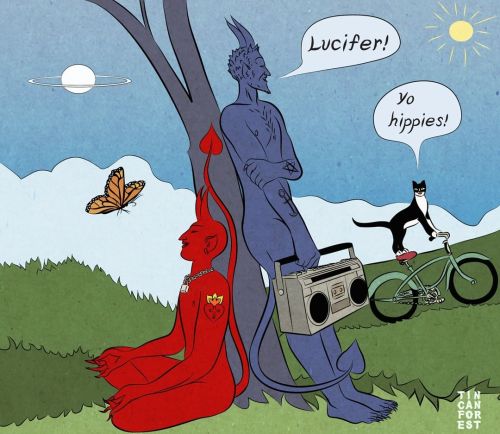
THE CIRCUS OF TUMBLRS!
- Bon Iver Erotica: A classic old-school Tumblr, this, which I am slightly-amazed I haven;t featured before, and which is a simple collection of 350 short romantic vignettes about Bon Iver. There are no datestamps on this, but it very much feels like 2009.
THE TROUGH OF (INSTA) FEEDS!
- Small Scale LA: Kieron is an artist making very small models of LA landmarks and buildings and cars and, look, who doesn’t love small things made with care and attention? NO FCUKER, etc.
- Johan Nohr: Thanks to Alex for sending this my way – Johan Nohr is a Swedish artist whose illustrations are a weird mix of horror, metal, scifi and videogame and whose overall aesthetic I enjoy very much indeed.
LONG THINGS WHICH ARE LONG!
- Life After Lifestyle: Ok, this is quite a long one and it is, I concede, quite w4nky, but if you have any interest in the general intersection between culture and commerce, if your job involves brands or branding or selling stuff in general, and ESPECIALLY if you have a silly, made-up job title like ‘strategist’ or ‘planner’ then you probably ought to read this. This covers culture and cults and commerce and how modern capitalism is effectively an amalgam of all three of those ‘cs’ is various quantities, and, more importantly, how it’s seeking to add an additional ‘c’ in terms of ‘community’. “The Lifestyle era was not about creating culture; it was about attaching brands onto existing cultural contexts. It was not about shaping people; it was about sorting consumer demographics into niche categories. The new order we are entering into reverses this. For some organizations, culture has become the product itself, and products have become secondary, auxiliary, to the production of culture.” This is so so so interesting, and kind-of ties together about half a dozen different essays from the past year or so including ones on lore and vibes…honestly, this is very, very good on What Is The Now.
- Why Every Designer Should Be A Systems Thinker: You know what I said about the last article and people with silly, made-up job titles? That, again. I usually have little or no interest in articles about being ‘better’ at one’s job (why would I want to be better at something so pointless?), but I thought this was an interesting way of thinking about how we approach problems and the ways in which we think about the contexts within which said problems exist. The title here specifically refers to ‘designers’, but, honestly, I think any reasonably-thinky profession (even useless, hateful ones like advermarketingpr!) can benefit from a more systems-ish approach and taking into account some of the ways of thinking here outlined.
- How AI Art Is Changing The World: A slightly-hyperbolic headline, but this is a decent overview of some of the main arguments around what the current boom in text-to-image generation is going to MEAN for a whole raft of industries and professions and practices. I would imagine that anyone reading this has thought enough about this themselves to already have arrived at these conclusions independently, but this is a useful article to share with people as a primer to a) what’s currently out there (as of a few days ago, at least – as I said up top, this is moving VERY FAST); and b) how it might be used in practice RIGHT NOW as part of the creative process for individuals and businesses.
- OpenSource AI: This is interesting – hyperbolic, true, and very much on a particular side of the ‘is all this AI-generated imagery going to be good for creatives?’ debate, but interesting. Daniel Jeffries recently joined Stability (the company that makes Stable Diffusion) as CIO, and this is a blogpost he wrote about how he sees the technology evolving and being used. Unsurprisingly he sees this as a BOON for artists, likening the doomsaying around its potential impact on low-level creative work to that which accompanied the advent of the portable camera (decried at the time as the death-knell for the painted image) and suggesting that tools like Dall-E and SD are going to become just another tool in the artist’s box rather than an artist replacement per se. There’s a lot of tooth-grinding ‘PUNK AI’ stuff buried in there too, and some not-particularly-robust self-justification about creating a no-limits image generator (literally of the ‘guns don’t kill people, people kill people’ calibre so beloved of the NRA), and the closing section where he glibly gives it the ‘machines can’t replace the ineffable creative spark of humans, guys!’ stuff seems to rather neatly sidestep the fact that a lot of ‘creative’ work that gets sold is very much not the sort of stuff that carries said ineffable creative spark…but it’s an interesting read, particularly given that these are the attitudes that will shape how this stuff develops over the coming months and years.
- The Creator Economy: A Power Law: I tend not to feature too much stuff by VC firms in here because, well, because mostly it’s garbage, but I found this piece by Mosaic Ventures interesting, mainly because it does a decent job of explaining (perhaps by accident) why the ‘creator economy’ numbers don’t stack up – it’s written from the perspective of startups wishing to sell to the apparent burgeoning creator class, and as such runs some basic numbers on who they are and how many of them can expect to be making enough to warrant a regular spend on creator-focused subscription tools, which ends up here: “The implication for software vendors is evident. For a startup building tools for creators, it’s crucial to go after accounts with more than 100k subscribers (or equivalent) – because these customers enjoy the lion’s share of revenue, audience engagement and ability to pay. Micro- / amateur creators make a small fraction of revenue and if they don’t succeed in breaking into the big time, there is a lot of churn.” If the people investing in this stuff feel this way about the likely buying power of creators, it doesn’t suggest a wonderful future in which we’re all going to be making bank from our exciting content.
- Tracking the Queue: A superbly-geeky and very interesting post about the work that went into tracking and managing the queue for the Queen’s lying in state. I know you don’t think you care about how they did the tech side of the ‘where is the queue right now?’ live updates, but I promise you that it is LOADS more interesting than you’d think, even if (like me) the tech stuff is basically all gibberish to you. “Just over a week ago, I got a call from a friend at DCMS asking for ideas on how they might help people to find the end of the queue for Her Majesty the Queen’s Lying-in-State. They had an interesting plan to livestream information to YouTube, and wanted to include some kind of live map alongside some dynamic public guidance. But how to get the data back and plot it realtime? Google (because if you’re DCMS, you just talk straight to Google…) didn’t have a ready solution since Google Maps doesn’t really have realtime pin movements. DCMS had an ingenious plan to use My Maps and shared location, with someone beaming back their location from the ground. But that would risk breaking if mobile signal dropped, or the phone battery died… and would need someone with the special phone at the back of the queue around the clock.” Fascinating, in only the way very niche things can be.
- Explaining the Tradwife Thing: This is included not because it’s a great piece of writing, but because it’s a neat illustration of something I have mentioned a few times now, most recently last week, namely the increasing push from certain quarters to push ‘traditional’ values as a resurgent, cool lifestyle choice (I think I first started seeing quotes along the lines of ‘the most punk thing you can do in the modern world is get married and have children and love God’ about…5-6 years ago) as a trojan horse for propping up existing capitalist superstructures. The fact that this has now reached a level of success whereby Mashable, ostensibly a tech industry publication, feels the need to run an article explaining that ‘traditionalism’ is not in fact a radical act of self-care and feminism but instead an example of capitalist control is, I think we can all agree, a sign that SOMETHING VERY WEIRD IS HAPPENING SOMEWHERE.
- TikTok and Video Search: Sorry, this is a second article from a VC firm but I promise that’s it and I won’t mention them again all year (probably). This one’s by A16Z, and comes hot on the heels of the latest piece of research which tells us that The Kids are using TikTok (and YouTube) for search over and above Google – the article looks at China for clues as to how this user behavious practically works, and how platforms and brands have evolved to take advantage of it. If you’ve spent any time in the far east over the past few years then this will all be old hat to you I’m sure, but those of you less well-travelled might find it interesting to consider how this stuff might play in the West in the coming years.
- The Physics of Cats: This is amazing – I strongly encourage you to read the whole piece, about how cats fall the way they do and how they survive, but I want you to take a moment to contemplate the big central takeaway here, namely THERE IS NO THEORETICAL LIMIT ON THE HEIGHT FROM WHICH A CAT COULD FALL AND STILL SURVIVE. Obviously this doesn’t take into account asphyxiation, etc, but I reckon there’s a decent possibility that a cat could do a parachuteless Felix Baumgartner and walk (ok, limp) away unscathed. Come on, Red Bull, what are you waiting for?
- The Sounds of Mexico City’s Streets: I love this so so so much – this is a gorgeous piece of work by The Pudding, which has taken the sounds of the streets of Mexico City (tamale sellers, fruit vendors, paperboys, etc) and woven them into this beautiful essay and interactive soundboard; this is so beautifully illustrated and made and recorded, and there’s such a pleasing level of detail in here about why the sounds selected are such an integral part of the city. I now want one of these for every capital city on Earth, so if the nice people over in editorial could get to that that would be lovely thankyou.
- The 100 Greatest TV Shows of All Time: Or at least ‘the 100 greatest TV shows of all time, as picked by Rolling Stone in a list designed to elicit a reasonable amount of discourse and rage’ – still, as lists go it’s not bad (although predictably US-centric) and it’s actually an excellent way of picking up new, slightly obscure series to binge through the cold and unfriendly winter months (although hang on, streaming costs money…fcuk it, instead why not just spend your time imagining what it would be like to watch the shows here described? Probably just as good). No spoilers here, but let me just tell you that I managed to get annoyed with this list within the first 10 entries (FCUK YOU THE MUPPET SHOW IS SO MUCH BETTER THAN JUST THE 92ND BEST TV SHOW EVER).
- Parenting and the Climate Crisis: This is an interesting piece of writing about how one’s approach to parenting is affected by the omnipresent futureterror engendered by, well, everything really, and how one ought to, or indeed can, respond. As I am sure you are bored of hearing, I don’t have children and never will and so I can’t speak to the practical value of the advice on offer here, but I found the ruminations here on the nature of time (time is really having a moment right now, turns out – stuff about time and our shifting perception of it is everywhere at present) and hope appealing, and pleasingly un-Pollyannaish.
- Drugs and Football: A look at the relationship between modern football culture and drugs, which goes back a few decades to chart the different ways in which the terraces have enjoyed getting on it over the years, leading up to what we are reliably told is the lawless coke-addled 16-pint seshfest that is today’s matchday. I really enjoyed the history here – from speed to pills to weed to coke as the years pass – and the sociology that accompanies it: ““For a short period, football violence was uncool and drugs played a major role in bringing this culture shift about,” Gilman wrote, arguing that his research offered “further evidence that experiences with psychedelic drugs can be important agents of personal, psychological, cultural and social change”. This is football in the Nineties. Hooligan casuals on inter-city rampages were old hat. Football was coming home and bringing ecstatic, loved-up pacifism with it.” As you might be able to tell by that last quoted line, the prose style here is a little bit too in love with its own ‘a voiceover to a documentary narrated by a geezer, but a smart one yeah?’ tone, but this is a good piece nonetheless.
- Tyson’s Fury: This is a beautiful essay about Mike Tyson and the weirdness of post-boxing Tyson, a man who, as the piece explains so poignantly, we excoriated for becoming the monster we so obviously wanted him to be. A really gorgeous piece of writing, which reinforces my personal “the best writing about boxing is better than the best writing about almost anything else” thesis quite nicely.
- Chemistry Read: Finally this week, a short story by Lisa Owens about an actress and the end of a relationship – I could have read 600 pages of this quite happily. I suggest you make a mug of something hot and sit somewhere comfortable and enjoy this, it’s a proper treat.

AND NOW, MOVING PICTURES AND SOUNDS!:
